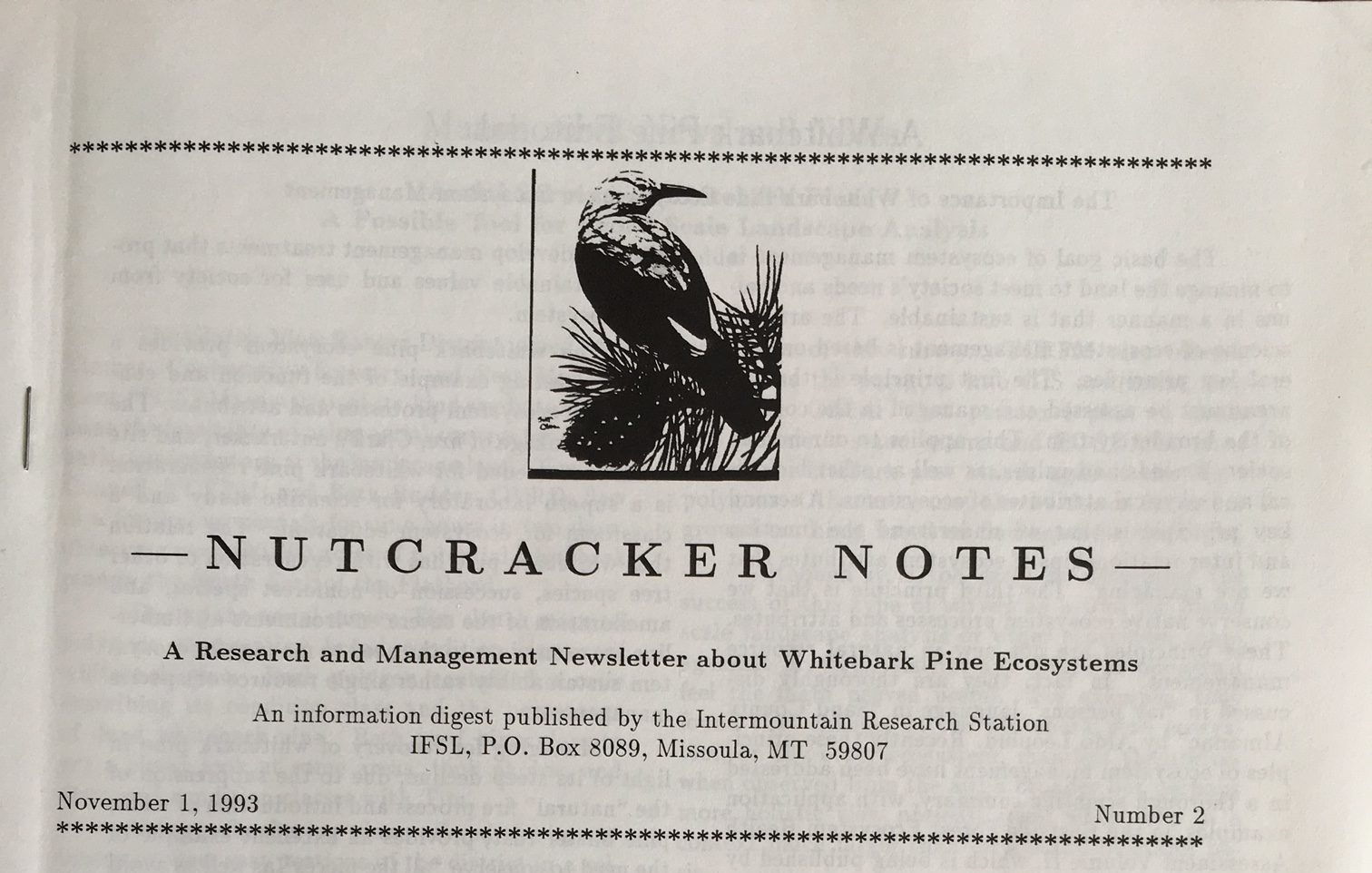
Way Back Whitebark – March 1994
Effects of Blister Rust on Post-fire Regeneration of Whitebark Pine: Case History–the Sundance Burn
By Diana F. Tomback, Ray J. Hoff, and Stephen F. Arno
This article appeared in a March 1994 issue of Nutcracker Notes – The third issue of the newsletter
In northern Idaho the Selkirk Range, Kaniksu National Forest, is an area heavily impacted by white pine blister rust. In 1967 wildfire burned over 22,600 ha of montane and subalpine zone forest, including seral whitebark pine communities. The burn, named for the point of origin of the fire, Sundance Mountain, provided a unique opportunity to compare whitebark pine regeneration density and the density distribution of regeneration with the similarly-aged Sleeping Child and Saddle Mountain burns of western Montana, which occur in areas of lower blister rust incidence. We were also interested in examining both the incidence and severity of blister rust infection in whitebark and western white pine and in determining any factors that might predict incidence and severity of infection.
Our field methodology was similar to that used for the Sleeping Child and Saddle Mountain burn studies. Beginning at the edge of the unburned whitebark pine seed source at the southeastern end of the burn, we established a 3.4 km transect heading northeast into the burn. The transect followed an elevation isocline, ranging between 1,775 and 1,849 m, to control for the effects of elevation on whitebark pine regeneration densities. Two parallel plots were established every 150 m along the transect, for a total of 46 plots; each plot was 50 m long and varied in width from 2.5 to 10 m, depending on local densities of whitebark pine. All whitebark pine and western white pine regeneration was measured for height, aged, and examined for symptoms of blister rust by means of Ecodata methodology (R. E. Keane and R. J. Hoff). With the help of Jane Kees and James Koehler at the University of Colorado at Denver, the data were statistically analyzed.
First of all, we determined that the density of whitebark pine regeneration in the Sundance Burn was significantly lower (one-sixth and one-ninth, respectively) than that found in the Sleeping Child and Saddle Mountain burns. However, as determined for both Montana burns, a scatterplot of whitebark pine density vs. distance from the seed source followed a negative exponential distribution–a pattern that is probably a consequence of nutcracker seed caching behavior.
For whitebark pine, 29% of the regeneration sites had blister rust symptoms (a regeneration site may support one seedling or a cluster of seedlings); for western white pine, 22% of the regeneration sites had blister rust symptoms. Only three seedlings each of whitebark and western white pine had died and showed blister rust symptoms. Thus, to date, blister rust was not a major cause of mortality and did not account for the low whitebark pine regeneration density. However, an examination of the whitebark pine seed source revealed few live whitebark pine trees; widespread mortality of whitebark pine predating the 1967 fire had occurred as a consequence of mountain pine beetle infestation. In addition, about a third of the living, cone-producing trees were infected with blister rust. Thus, lack of seed production to date accounted for the low levels of whitebark pine regeneration and not mortality caused by blister rust.
The future outlook for current regeneration in the Sundance Burn is not optimistic. Age and height of regeneration were two important predictors of incidence of blister rust infection for both whitebark and western white pine. By way of illustration, the average age and height of infected whitebark pine seedlings were nearly twice that of uninfected seedlings. Height alone was the major predictor of severity of infection (number of cankers per seedling). Thus, as seedlings become larger, they have a greater chance of being infected, and the severity of infection may increase; as a consequence, uninfected regeneration may become infected with time.
On the other hand, even though restocking the burn may be a slow process, it is likely that a large proportion of the surviving regeneration will be resistant to blister rust. Only after resistant trees are widespread and cone-producing will restocking of burns and clearcuts again occur in a natural timeframe.

